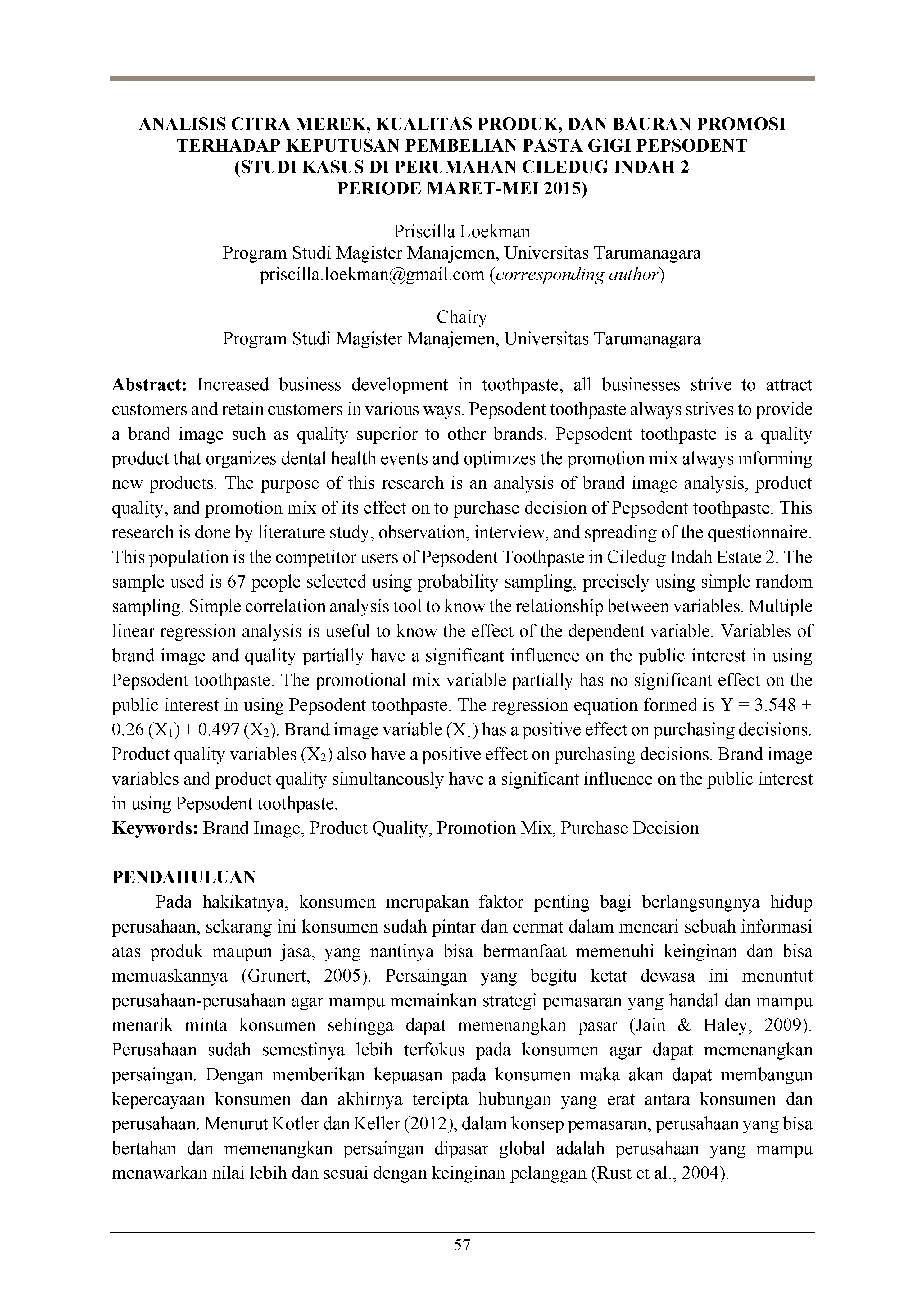Analisis citra merek, kualitas produk, dan bauran promosi terhadap keputusan pembelian pasta gigi Pepsodent (Studi kasus di perumahan Ciledug Indah 2 periode Maret-Mei 2015)
Main Article Content
Abstract
Increased business development in toothpaste, all businesses strive to attract customers and retain customers in various ways. Pepsodent toothpaste always strives to provide a brand image such as quality superior to other brands. Pepsodent toothpaste is a quality product that organizes dental health events and optimizes the promotion mix always informing new products. The purpose of this research is an analysis of brand image analysis, product quality, and promotion mix of its effect on to purchase decision of Pepsodent toothpaste. This research is done by literature study, observation, interview, and spreading of the questionnaire. This population is the competitor users of Pepsodent Toothpaste in Ciledug Indah Estate 2. The sample used is 67 people selected using probability sampling, precisely using simple random sampling. Simple correlation analysis tool to know the relationship between variables. Multiple linear regression analysis is useful to know the effect of the dependent variable. Variables of brand image and quality partially have a significant influence on the public interest in using Pepsodent toothpaste. The promotional mix variable partially has no significant effect on the public interest in using Pepsodent toothpaste. The regression equation formed is Y = 3.548 + 0.26 (X1) + 0.497 (X2). Brand image variable (X1) has a positive effect on purchasing decisions. Product quality variables (X2) also have a positive effect on purchasing decisions. Brand image variables and product quality simultaneously have a significant influence on the public interest in using Pepsodent toothpaste.
Article Details

This work is licensed under a Creative Commons Attribution-NonCommercial-ShareAlike 4.0 International License.
This work is licensed under a Jurnal Manajemen Bisnis dan Kewirausahaan Creative Commons Attribution-ShareAlike 4.0 International License.
References
Allenby, G. M., & Rossi, P. E. (1991). Quality perceptions and asymmetric switching between brands. Marketing Science, 10(3), 185–204. https://doi.org/10.1287/mksc.10.3.185
Athiyaman, A. (1997). Linking student satisfaction and service quality perceptions: The case of university education. European Journal of Marketing, 31(7), 528–540. https://doi.org/10.1108/03090569710176655
Cravens, D. W., & Piercy, N. (2006). Strategic marketing (8th ed.). McGraw-Hill.
Grunert, K. G. (2005). Food quality and safety: Consumer perception and demand. European Review of Agricultural Economics, 32(3), 369–391. https://doi.org/10.1093/eurrag/jbi011
Jain, S. C., & Haley, G. T. (2009). Marketing: Planning and strategy (8th ed.). Cengage Learning.
Kotler, P., & Keller, K. L. (2012). Marketing management (14th ed.). Prentice-Hall.
Priyatno, D. (2013). Analisis korelasi, regresi dan multivariate dengan SPSS. Gava Media.
Priyatno, D. (2014). SPSS 22 pengolah data terpraktis (T. A. Prabawati (ed.); 1st ed.). Andi.
Rust, R. T., Lemon, K. N., & Zeithaml, V. A. (2004). Return on marketing: Using customer equity to focus marketing strategy. Journal of Marketing, 68(1), 109–127. https://doi.org/10.1509/jmkg.68.1.109.24030
Steenkamp, J. B. E. M., Batra, R., & Alden, D. L. (2003). How perceived brand globalness creates brand value. Journal of International Business Studies, 34(1), 53–65. https://doi.org/10.1057/palgrave.jibs.8400002
Thakor, M. V., & Lavack, A. M. (2003). Effect of perceived brand origin associations on consumer perceptions of quality. Journal of Product & Brand Management, 12(6), 394–407. https://doi.org/10.1108/10610420310498821
Tjiptono, F., & Chandra, G. (2011). Service, quality & satisfaction (3rd ed.). Andi.
Tjiptono, F., & Chandra, G. (2013). Pemasaran strategik (2nd ed.). Andi.
Van Doren, D. C., Fechner, D. L., & Green-Adelsberger, K. (2000). Promotional strategies on the World Wide Web. Journal of Marketing Communications, 6(1), 21–35. https://doi.org/10.1080/135272600345534
Vigneron, F., & Johnson, L. W. (2004). Measuring perceptions of brand luxury. Journal of Brand Management, 11(6), 484–506. https://doi.org/10.1057/palgrave.bm.2540194
Völckner, F., Sattler, H., Hennig-Thurau, T., & Ringle, C. M. (2010). The role of parent brand quality for service brand extension success. Journal of Service Research, 13(4), 379–396. https://doi.org/10.1177/1094670510370054


